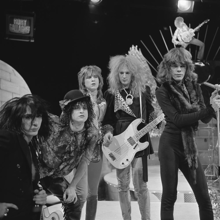| Revision as of 12:44, 17 December 2023 editTom.Reding (talk | contribs)Autopatrolled, Extended confirmed users, Page movers, Template editors3,891,546 editsm →top: Confirm {{Use dmy dates}} from 2013; WP:GenFixes & cleanup onTag: AWB← Previous edit | Revision as of 13:06, 17 December 2023 edit undoCAVincent (talk | contribs)Extended confirmed users5,238 edits that should be mdy; the Dolls were American, as are most other bands that might get tagged with this labelNext edit → | ||
| Line 1: | Line 1: | ||
| {{Short description|Fusion genre melding punk rock and glam rock}} | {{Short description|Fusion genre melding punk rock and glam rock}} | ||
| {{Use |
{{Use mdy dates|date=December 2023}} | ||
| {{Infobox music genre | {{Infobox music genre | ||
| | name = Glam punk | | name = Glam punk | ||
Revision as of 13:06, 17 December 2023
Fusion genre melding punk rock and glam rock
| Glam punk | |
|---|---|
| Stylistic origins | |
| Cultural origins | Early 1970s, New York City |
| Derivative forms | |
| Other topics | |

Glam punk is a proto-punk genre from the early to mid-1970s that incorporated elements of glam rock.
History
Glam punk has been seen as a backlash to the hippie folk music sensibilities of the 1960s. Lucy O'Brien defines the New York Dolls style as combining "Rolling Stones raunch with heavy borrowings from the girl group era". The band was highly influential in New York City's club scene of the early 1970s, as well as with later generations of musicians, and their style was adopted by a number of New York bands, including Ruby and the Rednecks. The Dolls broke up in 1976, by which time the trend had already metamorphosed into punk and begun to move on to new wave.
Influence
The New York Dolls helped spark the beginning of punk rock, with Malcolm McLaren informally managing them in 1975, before returning to England, where he and Vivienne Westwood used the New York Dolls, as well as other bands that they had seen while in New York, as inspiration for punk fashion and the creation of the Sex Pistols. They also influenced the glam metal scene that emerged in the 1980s, through the adoption of glam aesthetics by bands including Hanoi Rocks, Mötley Crüe and Guns N' Roses.
The term has been used to describe later bands who combined glam aesthetics with punk music, including early Manic Street Preachers. Glam punk was a major influence on bands of the New York post-punk revival that included D Generation, Toilet Böys, and The Strokes.
See also
References
- Havranek, C., ed. (2009). Women Icons of Popular Music: the Rebels, Rockers, and Renegades. Vol. 1. Westport, CT: Greenwood. p. 164. ISBN 0-313-34084-6.
- O'Brien, Lucy (2002). She Bop II: The Definitive History of Women in Rock, Pop and Soul. Continuum. p. 258. ISBN 0-8264-7208-7.
- Givens, T. (2007). People of Paradox: a History of Mormon Culture. Oxford: Oxford University Press. p. 281. ISBN 0-19-516711-2.
- "Ruby and the Rednecks at the Mercer Arts Center". September 3, 2018.
- McNair, Brian (2002). Striptease Culture: Sex, Media and the Democratization of Desire. London: Routledge. p. 136. ISBN 0-415-23734-3.
- Gross, David. "David Johansen". Perfect Sound Forever. Archived from the original on December 29, 2010. Retrieved February 25, 2012.
- Moore, R. (2009). Sells like Teen Spirit: Music, Youth Culture, and Social Crisis. New York: NY: New York University Press. p. 47. ISBN 978-0-8147-5747-5.
- Bukszpan, D. (2003). The Encyclopedia of Heavy Metal. New York City, NY: Barnes and Noble. p. 85. ISBN 0-7607-4218-9.
- Strauss, N. The Dirt: Confessions of the World's Most Notorious Rock Band.
- Davis, S. (2008). Watch You Bleed: The Saga of Guns N' Roses. New York, NY: Gotham Books. p. 30. ISBN 978-1-59240-377-6.
- Jovanovic, R. (2010). A Version of Reason: The Search for Richey Edwards. London: Hachette UK. ISBN 1-4091-1129-6.
- Harrington, J. S. (2003). Sonic Cool: the Life and Death of Rock 'n' Roll. Milwaukee, WI: Hal Leonard Corporation. p. 38. ISBN 0-634-02861-8.
| Rock music | |||||||||||||
|---|---|---|---|---|---|---|---|---|---|---|---|---|---|
| Components | |||||||||||||
| Genres by decade of origin (sub-subgenres not included) | |||||||||||||
| Regional scenes |
| ||||||||||||
| Radio formats | |||||||||||||
| |||||||||||||
| Related | |||||||||||||